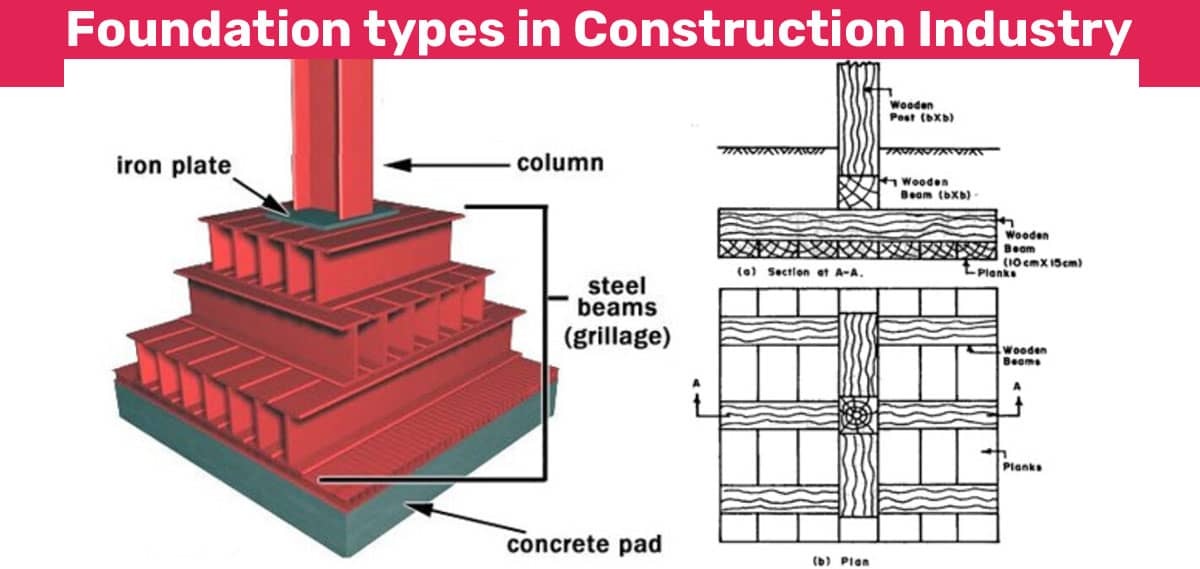Foundation types in Construction Industry

These days, we will communicate approximately the commonplace forms of foundations in homes. generally, all foundations are divided into 2 categories: shallow and deep. The words 'shallow' and 'deep' check with the intensity of soil for the duration of which the muse is created.
Shallow foundations can be created in depths of as little or no as 3 feet, while deep foundations may be created at depths of sixty - 2 hundred toes. Shallow foundations are used for little, lightweight buildings, while deep ones are for giant, severe homes. the following types of Foundations In building creation can be elaborated under.
Raft or Mat Foundations
Raft Foundations, conjointly referred to as Mat Foundations, are maximum frequently used as soon as basements are to be made. In a raft, the whole basement floor block serves as the muse; the weight of the constructing is unfold equally over the complete footprint of the building. it is known as a raft due to the building is form of a vessel that 'floats' in an incredibly ocean of soil.
Mat Foundations are used anyplace the soil is weak, and accordingly building loads need to be compelled to fulfill an oversized area, or wherever columns are carefully spaced, which indicates that if character footings were used, they may hit one another.
Shallow Foundations
Shallow foundations are known as unfold footings or open footings. The 'open' refers to the very truth that the principles are created via 1st excavating all the planet until of the footing, so building the footing. at some point of the primary levels of hard work, the whole footing is visible to the attention, associated is so referred to as an open foundation.
The concept is that every footing takes the targeted load of the column and spreads it out over an oversized area,so that the particular weight at the soil would not exceed the secure bearing capability of the soil.
there are many kinds of shallow footings: individual footings, strip footings and raft foundations.
In cold climates, shallow foundations must be protected against freezing. this may be because of water inside the soil round the foundation can freeze and enlarge, thereby destructive the muse. these foundations need to be engineered beneath the frost line, that is that the extent within the floor higher than which freeze takes place.
In the event that they can't be engineered beneath the frost line, they need to be blanketed by using insulation: usually a touch warmness from the constructing can permeate into the soil and prevent freeze.
Character Footings
Person footings are one in every of the foremost straightforward and customary styles of foundations. These are used as soon as the load of the construction is carried by using columns. Typically, every column will have its own footing. The footing is certainly a rectangular or square pad of concrete on that the column sits.
To get an awfully tough plan of the scale of the footing, the engineer can take the overall load on the column and divide it by way of the safe bearing capability (SBC) of the soil. For instance, if a column includes a vertical load of 10T, and additionally the SBC of the soil is 10T/m2, then the region of the footing area 1m2.
In software, the style can discover several various factors before making equipped a creative layout for the footing. Individual footings are commonly related by means of an assist beam, a horizontal beam that is engineered at the ground or underground degree.
Pile Foundations
A pile is largely a prolonged cylinder of an effective material like concrete that's pushed into the lowest just so systems may be supported on prime of it. Pile foundations are utilized in the subsequent conditions:
While there is a layer of weak soil on the surface. This residue can't guide the burden of the construction, consequently, a number of the constructing has to be forced to bypass this accretion and be transferred to the layer of more potent soil or rock this is beneath the vulnerable layer.
While a building has extraordinarily severe, targeted masses, inclusive of in a very excessive upward push shape. Pile foundations are capable of taking better loads than spread footings. There are 2 sorts of pile foundations, everyone in each of them works in its personal method.
Cease Bearing Piles
In quit-bearing piles, the lowest-low end of the pile rests on a layer of especially sturdy soil or rock. The load of the construction is transferred through the pile onto the sturdy layer. In a sense, this pile acts a form of a column.
The key principle is that the lowest low quit rests at the floor this is that the intersection of a weak and powerful layer. The load so bypasses the susceptible layer and is competently transferred to the strong layer.
Friction Piles
Friction piles work on a special precept. The pile transfers the burden of the building to the soil across the total top of the pile, by friction. In distinct phrases, the complete floor of the pile, which is cylindrical in shape, works to switch the forces to the soil.
To visualize how this works, imagine you're pushing a strong metal rod of around 4mm diameter into a tub of frozen ice cream. As soon as you've got pushed in, it's robust sufficient to support some load. The bigger the embedment depth in the frozen dessert, the extra load it's going to help. This could be fairly almost like a friction pile works. In an extremely friction pile, the variety of load a pile will assist is at once proportional to its period.
In practice, however, each pile resists load with the aid of a mixture of finish bearing and friction. Primarily are basic sorts of Foundations In building production.
For more information, please watch the following video tutorial
